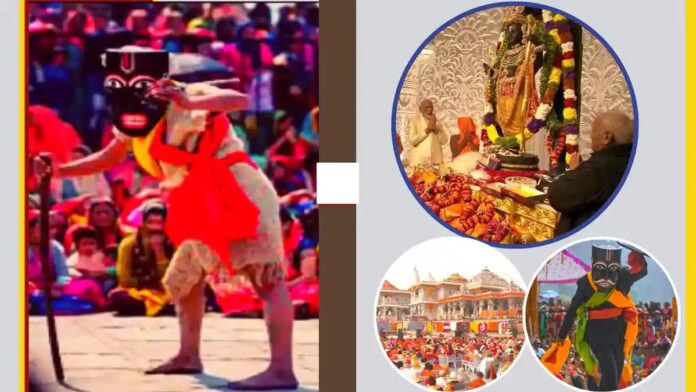Chamoli (News Trust of India) : The Ramman fair in Uttarakhand intertwines with the illustrious account of the Ramayana, where the mask dance has a profoundly historical significance. Presently, after five centuries of rigorous labor, a magnificent Ram temple has been erected in Ayodhya. The Ayodhya Ram Mandir Pran Pratishtha Samaroh unfolded its splendor today. Following the reverence of Ram Lalla within the sacred confines of the Ram temple, an air of intense devotion penetrates the entire nation. The public is enthralled in the bright tapestry of adoration for Lord Rama. On this remarkable moment, NTI attempts to acquaint you with the uncommon mask dance closely related with the heavenly achievements of Lord Rama. This mask dance unveils its grandeur in the Chamoli district of Uttarakhand, an art so historically significant that it has received respect on the global arena, blessed by UNESCO.
The mask dance, intermingled with the tales of Rama’s celestial pastimes, is marked as Rammaan. To mark this, a large Ram Nirman Mela is arranged in the Chamoli district. The nexus of Uttarakhand becomes the main point of the Chamoli construction heritage. The Joshimath block in Chamoli is recognized as the abode of gods, noted for its peculiar lifestyle, culture, and religious establishments. This precious country witnessed the entrance of Adi Guru Shankaracharya in the concluding years of the 8th century. Shankaracharya consecrated three monasteries in this world – Jyotirmath, Amimath, and Thaulingamath. Surprisingly, one of these monasteries, Thaulingamath, currently exists in Tibet.
This region also symbolizes the founding of the globally recognized Badrinath Dham by Shankaracharya, one of the four hallowed abodes in the realm of Sanatan. Adi Guru Shankaracharya, 44 kilometers prior to Badrinath Dham, finished the consecration of Atharvaveda at Jyotirmath, residing in the Badrikashram area for four productive years. Here, he composed the Brahmasutra Bhashya, the Gita Bhashya, and the Vishnu Sahasranama Bhashya.
The paramount Ramzan celebration unfurls its brilliance at Salur hamlet in Chamoli district, staged under the aegis of the district panchayat. Ramna Mela spreads its exuberance for 11 or 13 days, embracing a range of ceremonies comprising public devotion, Dev Yatra, folk theatre, dancing, singing, and celebratory gatherings. Every caste actively participates in this commemoration. The Ramnarayan dance contains a unique portrayal of characters like Kurujogi, Banyan, and Maal, inspiring amusement while communicating environmentally vital ideas. As the conclusion of Ramnaan approaches, the Bhumiyal Gods make their presence felt, bringing blessings of joy and prosperity.
The special element of the Rammaan Mela resides in its portrayal of the complete Ramayana in a compact form through the art of dance. Clad in traditional outfits, Ram-Lakshman-Sita-Hanuman gracefully dance to 18 distinct tunes and beats throughout the day. Crucial events from the Ramayana, such as the birth of Rama-Lakshmana, their travel to Janakpuri, Sita Swayamvar, stay in the forest, Swarna Badha, Sita Haran, Hanuman Milan, Lanka Dahan, and Rajtilak, unfold with artistic elegance in the enthralling Ramnaan dance.


